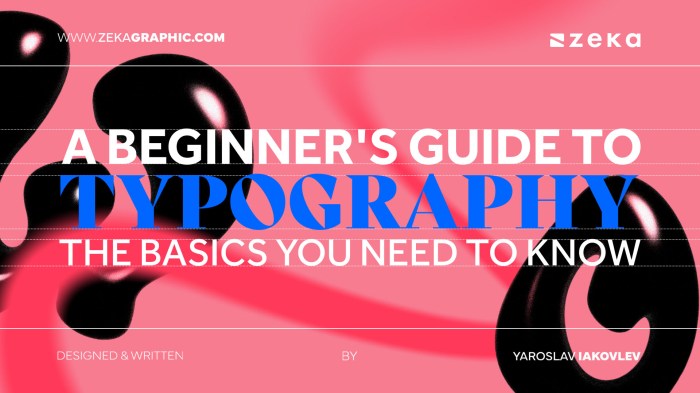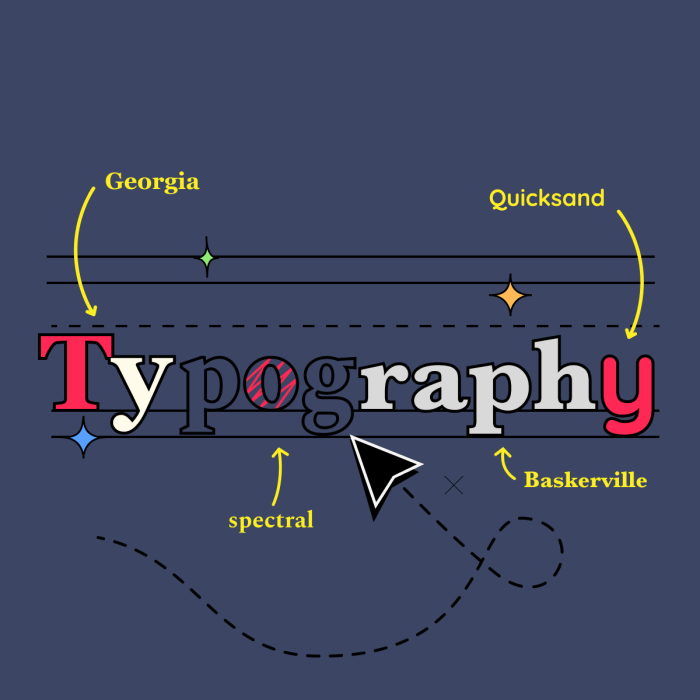Crafting Compelling Typography Design: A Guide to Enhancing Visual Communication
As typography design continues to play a crucial role in visual communication, this introduction invites readers into the world of fonts, spacing, and alignment, offering a glimpse into the artistry behind effective design.
Exploring the significance of typography design and its impact on brand identity, this overview sets the stage for an in-depth discussion on the key elements that shape captivating visual messages.
Introduction to Typography Design
Typography design is the art and technique of arranging type in a visually appealing and readable way. It plays a crucial role in visual communication by conveying messages effectively through the use of text. Typography is not just about selecting fonts but also about considering factors like spacing, alignment, and overall layout to enhance the readability and aesthetic appeal of the text.
Significance of Typography in Visual Communication
Typography design is essential in creating a strong brand identity as it helps in establishing a consistent look and feel across various communication materials. The choice of fonts, colors, and layout can evoke specific emotions and associations, helping to differentiate a brand from its competitors.
Good typography design can enhance the overall user experience and leave a lasting impression on the audience.
Key Elements of Typography Design
- Font: The selection of font style, size, and weight can greatly impact the readability and visual appeal of the text. Different fonts convey different tones and emotions, so it's important to choose fonts that align with the brand's personality and message.
- Spacing: Proper spacing between letters, words, and lines is crucial for readability. Adjusting the spacing can help improve legibility and overall visual balance of the design.
- Alignment: The alignment of text can influence the flow and hierarchy of information. Whether text is aligned left, center, right, or justified can impact how the reader perceives the content and the overall design aesthetic.
Principles of Typography Design

Choosing the right font type is crucial in typography design as it sets the tone and communicates the message of the design project. Different font types convey different emotions and aesthetics, so selecting the appropriate one can greatly impact the overall feel of the design.Font size and style play a significant role in readability and user experience.
The size of the font affects how easily the text can be read, especially in terms of legibility. The style of the font, such as serif or sans-serif, can also influence readability and user engagement. It is essential to consider these factors to ensure that the text is easily readable and visually appealing to the audience.Typography hierarchy is essential for guiding the reader's attention and organizing the content.
By using different font sizes, weights, and styles, designers can create a visual hierarchy that helps users navigate the text and understand the importance of each element. This hierarchy aids in directing the reader's focus and ensuring that the most critical information stands out effectively.
Typography Design Techniques

When it comes to typography design, various techniques can be employed to create visually appealing and effective designs. Pairing fonts, utilizing color, and playing with contrast and hierarchy are essential aspects of typography design that can significantly impact the overall look and feel of a design project.
Pairing Fonts Effectively
Effective font pairing is crucial in typography design as it can help establish hierarchy, convey tone, and enhance readability. When pairing fonts, it's essential to consider the contrast between the typefaces to ensure they complement each other while still offering enough distinction to create visual interest.
For example, pairing a bold, attention-grabbing heading font with a simpler, more readable body font can create a balanced and harmonious design.
Using Color in Typography Design
Color plays a vital role in typography design by adding visual interest, creating emphasis, and conveying mood. By incorporating color strategically, designers can draw attention to specific elements, highlight important information, and evoke certain emotions. For instance, using a pop of color for headings or key words can help guide the viewer's eye and make the content more engaging and impactful.
Utilizing Contrast and Hierarchy
Contrast and hierarchy are essential design principles that can elevate the visual appeal of typography. Contrast can be achieved through variations in font size, weight, color, and style to create visual interest and guide the viewer's attention. By establishing a clear hierarchy through size, placement, and styling of text elements, designers can effectively communicate the importance of different pieces of information and improve readability.
Typography Design Tools
When it comes to typography design, using the right tools can make a significant difference in the efficiency and quality of your work. There are several popular tools and software specifically designed for typography design, each offering unique features and capabilities.
Popular Typography Design Tools
- Adobe Illustrator: Known for its versatility and powerful tools, Adobe Illustrator is a top choice for many designers when it comes to typography design. It offers a wide range of features like variable fonts, precise controls, and seamless integration with other Adobe Creative Cloud apps.
- FontLab: FontLab is a professional font editor that allows designers to create, edit, and customize fonts with ease. It offers advanced typography tools, font hinting, and support for various font formats.
- Sketch: While primarily a UI/UX design tool, Sketch also offers robust typography features that make it a favorite among designers. It allows for easy text manipulation, smart layouts, and export options for web and print projects.
- Glyphs: Glyphs is another popular font design software that provides designers with powerful tools for creating custom fonts, spacing adjustments, and kerning control. It is known for its user-friendly interface and efficient workflow.
Features and Benefits of Typography Design Tools
Typography design tools streamline the design process by offering specialized features that cater to the unique requirements of working with text. These tools improve efficiency by providing:
- Precise control over typography elements like font size, spacing, and alignment.
- Access to a wide range of fonts and typefaces for experimentation and creative exploration.
- Tools for custom font creation, editing, and manipulation to achieve the desired look.
- Automation features for repetitive tasks like batch processing, font generation, and style variations.
- Integration with other design software for a seamless workflow and easy collaboration.
Typography Trends
Typography design trends play a crucial role in shaping the visual identity of brands and conveying messages effectively. Let's explore the current trends in typography design across various industries and how technology and societal changes influence these trends.
Digital Typography
Digital typography continues to evolve with the increasing demand for responsive and user-friendly designs. Variable fonts, which allow for more flexibility in adjusting weight, width, and other attributes, have gained popularity for their ability to enhance readability across different devices and screen sizes.
- Variable fonts offer designers greater creative freedom and efficiency in typography design.
- Animated typography, such as kinetic typography in videos and websites, adds a dynamic element to visual storytelling.
- Experimental typography, including glitch effects and distorted text, pushes the boundaries of traditional typography design.
Minimalist Typography
Minimalist typography remains a prevalent trend across industries, reflecting a clean and sophisticated design aesthetic. Sans-serif fonts with ample white space and simple layouts are favored for their timeless appeal and readability.
- Minimalist typography conveys a sense of elegance and modernity in branding and editorial design.
- Monochromatic color schemes and understated typography help create a cohesive and polished visual identity.
- Negative space is utilized strategically to emphasize key messages and maintain visual harmony.
Inclusive Typography
Inclusive typography focuses on creating designs that are accessible and inclusive for all audiences, including those with visual impairments or disabilities. Designers are increasingly incorporating features such as high contrast, larger font sizes, and clear hierarchy to improve readability and usability.
- Accessible typography ensures that content can be easily consumed by individuals with varying visual needs.
- Emphasis on readability and legibility in typography design promotes inclusivity and user-friendly experiences.
- Alternative text descriptions and audio descriptions are integrated to enhance accessibility for screen readers and assistive technologies.
Final Conclusion
In conclusion, typography design serves as a powerful tool in conveying messages and creating memorable experiences for audiences. By understanding the principles, techniques, tools, and trends in this field, designers can elevate their projects to new heights of creativity and impact.
FAQ Corner
How does font selection impact the overall design?
Font choice can significantly influence the mood, readability, and visual appeal of a design, making it essential to select fonts that align with the project's objectives.
What role does color play in typography design?
Color can be used to evoke emotions, create hierarchy, and enhance the overall aesthetic of typography design, adding depth and visual interest to the composition.
Why is typography hierarchy important in design projects?
Typography hierarchy helps establish a visual hierarchy, guiding the viewer's attention and organizing content in a way that enhances readability and comprehension.




